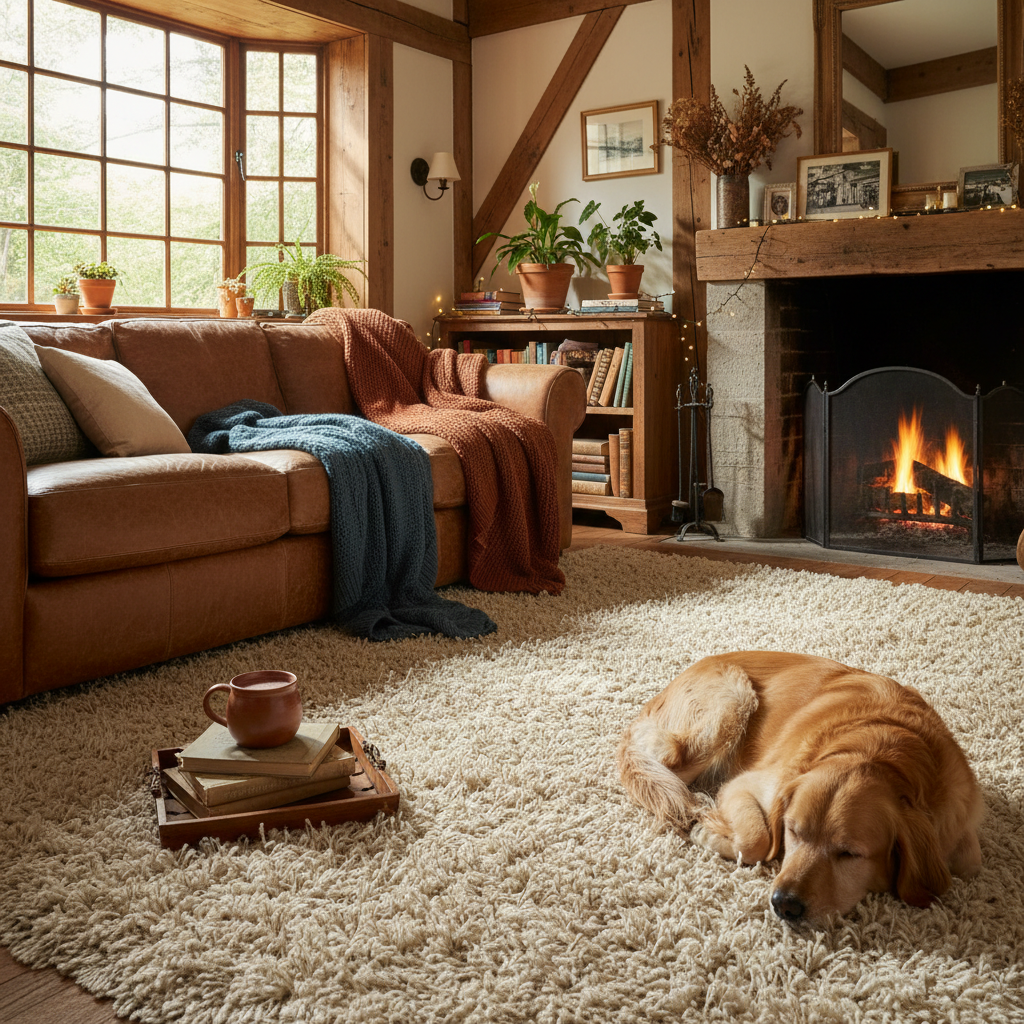Best Carpet Underlay in 2025
Share
Copy Link
Underlay is a fundamental part of buying a new carpet. It's important that you do some research before replacing your flooring, making sure that you choose the right carpet underlay for your home.
Often when we are choosing a new carpet, we focus on buying a beautifully soft carpet that feels luxurious and soft underfoot, only to be disappointed a couple of years later when it begins to harden and flatten. This is partly because of the type of carpet chosen, but the underlay plays a crucial role in your carpet’s ability to ‘bounce back’ over time.
The benefits of carpet underlay
The benefits of carpet underlay are many and include:
Noise reduction
Carpet underlay will help soundproof your home, so it's perfect if you have a busy household! Or if you live on a first-floor flat, you may want to invest in a high-performing underlay to reduce the noise for your neighbours. Carpet underlay will help with the impact noise of people walking in the room above.
Your carpet will look better for longer
Good quality underlay will stop the pile flattening and so the carpet will look new for longer. As the underlay acts as a shock absorber, your carpet will sit better and take more wear.
Carpet will feel softer
Your carpet will feel more luxurious and softer underfoot with the extra cushioning that underlay provides. Some types of underlay will provide more cushioning and it often pays to choose thicker and more cushioned underlay in areas such as the bedroom where you want the carpet to feel extra soft underfoot.
Reduce energy bills
The best type of carpet underlay will reduce your energy bills as it will keep the heat in your room. If you plan on living in your property for longer, consider investing in a good-quality thermal underlay.
The tog rating of carpet underlay will impact the energy efficiency, so look out for something over 2.5 to keep your home cosy and draught-free!
Your carpet is easier to clean
As the carpet pile is protected, the carpet is easier to clean and dust will be removed more easily.

How much should you pay for underlay?
Expect to pay from £3m² for a budget underlay, up to £10m² for a premium thermal underlay. Invest more in areas of high traffic such as the stairs and hallways as it will help the carpet retain its appearance and shape for longer. You can secure a great quality carpet underlay for around £5m².
When choosing a new carpet, it's a common error to budget for the carpet and then choose the cheapest underlay. Think about allocating slightly more to the underlay and your carpet will last for years more.
Do I always need to replace the carpet underlay?
Yes, there is no point investing in a new carpet on top of old underlay. It might provide the carpet decent support for a few years but ultimately will not last as the carpet itself will start going flat.
Where can I buy carpet underlay?
High street carpet retailers often mark up their underlay greatly, as they have much higher overheads, which means you can secure a large discount or better quality product for your budget if you shop around online.
How thick should carpet underlay be?
Underlay can give your carpet a lovely cushioned feeling so for areas designed for lounging (think bedrooms and living rooms) you should opt for as thick an underlay as possible. Something around 10-12mm is ideal and will give you that sense of luxury and comfort underfoot.
However, extremely thick underlay on the stairs is a no-go. “Installing a substantial 12mm underlay on the stairs is not only tricky for the fitter when it comes to bending it around the tread and riser, but it can also be a safety hazard. It’s for this reason we would always recommend a thinner, denser underlay around 8-9mm,” says Jones.
Should I consider the tog rating of carpet underlay?
Tog rating is important when choosing your carpet underlay and should be a key purchasing consideration. Tog is a measure of thermal resistance and indicates how much heat is able to transfer through the material. Think of it like your duvet - you opt for one with a higher tog rating when you want to keep warm in the depths of winter, but most people will then switch to a lower tog in the summer months when the nights are warmer.
Carpet underlay tog rating is determined by the composition, density and thickness of the product. Carpet underlay tends to vary from 1.0 to 4.0 tog rating.
However, a high tog rating isn't always optimum in all homes - if you have underfloor heating then you should choose a lower tog to allow the warmth to easily pass through the underlay into your room.
An underlay with a tog rating of less than 1.0 is required for underfloor heating to maintain the efficiency of the system. Do check that your underlay is compatible with underfloor heating and will cope with high temperatures - you are best to invest in a specialist underfloor heating underlay.
You should choose a tog of 2.5 or over if you don't have underfloor heating as it will help the room heat up quicker and retain heat better, potentially leading to lower energy bills.
So what is the best type of carpet underlay?
A good carpet underlay will provide thermal insulation, reduce noise, make the carpet feel softer underfoot and extend the carpet’s lifespan by acting as a shock absorber.
But the best carpet underlay is the one that fits your specific needs and requirements.
“When shopping for carpet underlay, you should think about what you want from your space first. Do you have a busy home and need additional soundproofing? Go for an underlay with a high sound impact rating. Do your rooms feel chilly all the time? Go for the highest tog value you can. Want pure luxury in your bedroom? Try a thick 12mm underlay made from memory foam,” advises Jones.
There is a wide variety of carpet underlay to choose from, with the most popular types being polyurethane (PU) foam, rubber and felt.
1. PU Foam
PU foam remains a popular choice as it gives a lovely soft feeling underfoot. PU foam is made from recycled furniture foam and offcuts, so it's an environmentally friendly option that can be recycled again after use.
PU foam is available in various thicknesses depending on budget. The thicker the underlay, the better the insulation, luxurious feel and noise reduction.
Pros
- Soft underfoot
- Excellent thermal insulator
- Environmentally friendly
Cons
- Will flatten over time
- Will not recover as easily from furniture as rubber will
Best for...
- The bedroom where you want a really soft feeling underfoot and have less wear, so less inclined to flatten
2. Rubber
Rubber is great at soundproofing as well as protecting the carpet. Extremely dense and heavy in comparison to foam, rubber has been used for years in commercial environments as it’s durable and resilient enough to withstand heavy foot traffic.
Rubber carpet underlay comes in two key forms: sponge rubber and crumb rubber.
Sponge rubber
Sponge rubber comes in the traditional waffle form or the more modern flat rubber. Waffle takes its name from the pattern of the underlay which creates an air bubble or pocket. These are great for trapping heat and sound, making sponge rubber an excellent insulator.
Pros
- Soft underfoot (the softest after PU foam)
- A firm underlay
Cons
- Can disintegrate and flatten over time if you buy cheap
- Waffle sponge rubber flattens easily
Best for...
- Waffle sponge rubber is better suited to areas such as the bedroom with low traffic
- Flat sponge rubber performs well in areas of high traffic
Crumb rubber
Crumb rubber is made from recycled car tyres, so it's an environmentally-friendly option. It is very firm and provides good support to the carpet.
Pros
- Extremely dense and firm
- Excellent soundproofing
- Recovers well from furniture marks
- Environmentally friendly - often made from around 80% recycled materials
Cons
- Can feel firm underfoot
Best for...
- Areas of high traffic such as the stairs or rooms with heavy furniture
- Popular for commercial properties as its hard-wearing
3. Felt
Felt underlay is a traditional choice and has a high wool content, making it great for insulation.
Pros
- Extremely firm
- Excellent thermal properties
- Recovers well from furniture marks
Cons
- Not luxurious underfoot
Best for...
- Stretched woven carpets

What other types of underlay are there?
Flooring other than carpet requires underlay. You can get underlay for luxury vinyl which is made of rubber and helps the tiles to stick to the underlay. This will also help with noise reduction and improve thermal performance.
You can also get carpet underlay for wooden and laminate flooring which can cover up any minor floor irregularities, providing more stability and insulation. We do recommend that you speak with the flooring supplier as to whether you will need this for your specific flooring.
Published: October 13, 2025



